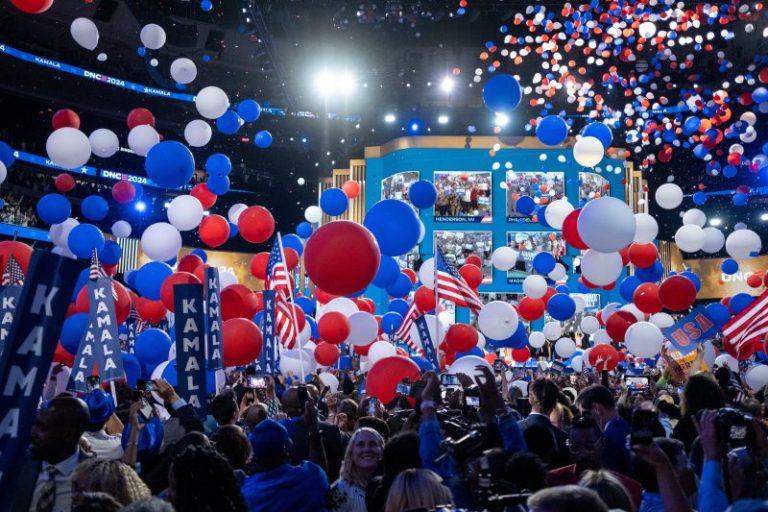The Democratic National Convention in Chicago drew generally positive impressions from a key swath of voters in battleground states surveyed by The Washington Post.
Optimism, energy and support for Democratic nominee Kamala Harris were the most common themes that stood out to sporadic or uncommitted voters.
To gauge voters’ reactions, The Post sent out an email to participants in a spring poll of registered voters in six battleground states in conjunction with George Mason University’s Schar School.
The callout asked voters to explain: “What stood out to you most from the Democratic convention?” They were also asked to describe ideas they heard that were both good and bad.
Of the 111 respondents, 75 watched or listened to the convention or news about it and were asked for their reactions, offering a glimpse at responses to the Democratic convention among potentially decisive voters, though the sample is too small to provide statistically meaningful results. Those who replied were allowed to answer the questions confidentially, as is typical in public opinion surveys.
One Pennsylvania Democrat, a 55-year-old White woman, saw a re-energized party on display over the four days. “There’s more excitement and anticipation with Kamala Harris than I’ve seen since Obama,” she said. “People seem more energized and hopeful for the future.”
She also listed several issues Democrats talked about that she thought would be good for the country: “Stabilizing the economy, restoring reproductive choices and rights, immigration.”
A Michigan independent woman who leans Democratic noted how different the Democratic convention tone was from the Republican one. “One highlighted inclusivity and joy, and the other fear mongering and misrepresentations and outright lying.” The 70-year-old added that she found it wonderful “to see so many women in so many different positions in government come out and speak. It was inspiring.”
The most common criticisms were that Democrats focused too much time attacking former president Donald Trump while not explaining their policies.
“Most of the speeches seemed to be ad hominem attacks against Trump rather than [talking] about policy,” a 21-year-old White Republican woman in Georgia said.
All of the voters contacted are part of a large pool of people The Post and Schar School have classified as “Deciders,” voters who either had not been firmly committed to President Joe Biden or Trump or whose participation in November is not wholly predictable because of their age, voting history or both. The Post’s Deciders live in one of six key swing states: Arizona, Georgia, Nevada, Michigan, Pennsylvania or Wisconsin.
Overall, 50 of the 111 voters who responded said they had a “positive” general impression of the Democratic National Convention, while 25 were negative.
About one-third of the respondents, 36 of them, said they didn’t watch or listen to the convention or the news about it, so they were not asked for their reactions to the Democrats’ convention. Self-identified Democrats and 2020 Biden voters were more likely to watch the Democratic convention, resulting in more positive impressions of the convention.
A Georgia voter who identified as a Republican but will probably vote for Harris said it appeared that people preferred Harris over Biden as the party’s nominee. The 20-year-old Black man characterized the speech by Harris’s husband, Doug Emhoff, as “interesting.” He said he also liked the Obamas’ speeches and hearing Republicans speaking out against Trump.
Others also praised Democrats for bringing in a lineup of Republicans such as former congressman Adam Kinzinger and Stephanie Grisham, a former White House press secretary and aide to former first lady Melania Trump.
“The thing that stood out to me was the fact that registered Republicans came out to speak on Harris’s behalf,” one Democrat from Wisconsin, a 21-year-old White woman, said. She added that she found vice-presidential candidate and Minnesota Gov. Tim Walz to be relatable and liked his politics.
While many reviews were positive, some felt that the convention spent too much time attacking the other side.
“The thing that stood out the most was too much Trump-bashing. I am 100% against Trump,” said a 47-year-old White man, a Michigan Democrat who plans to vote for Harris. “But I thought that it was unnecessary for so many of the speakers to continue with the same rhetoric about Trump. It was almost too much.”
Some had criticisms of Harris’s message, such as one 32-year-old White man from Michigan.
“Kamala Harris again has failed to outline policy proposals and tell us what she would do as president,” said the man, a Republican-leaning independent. “The things that she has stated she would do are all things that could have been worked towards during her time as Vice President but she did nothing.”
Several voters said they simply enjoyed watching the convention.
A 23-year-old Asian American Democrat from Michigan named “Lil Jon’s performance and Obama’s speech” as his biggest highlights from the convention. And a 36-year-old White woman from Nevada who also identifies as a Democrat said simply, “The speakers were hopeful and inspiring.”
This Deciders callout was conducted by The Washington Post and George Mason University’s Schar School of Policy and Government on Aug. 23, 2024, among a sample of 111 registered voters in Arizona, Georgia, Michigan, Nevada, Pennsylvania and Wisconsin who turn out sporadically or were uncommitted to Biden or Trump this spring. Respondents completed the survey online via an email link. The sample was drawn from the participants of a Deciders survey conducted in April and May, which was drawn from an L2 database of registered voters in each state. Deciders are defined as those who voted in only one of the past two presidential elections; are between ages 18 and 25; registered to vote since 2022; did not plan to vote for either Biden or Trump in the May survey; or switched their support between 2016 and 2020.

